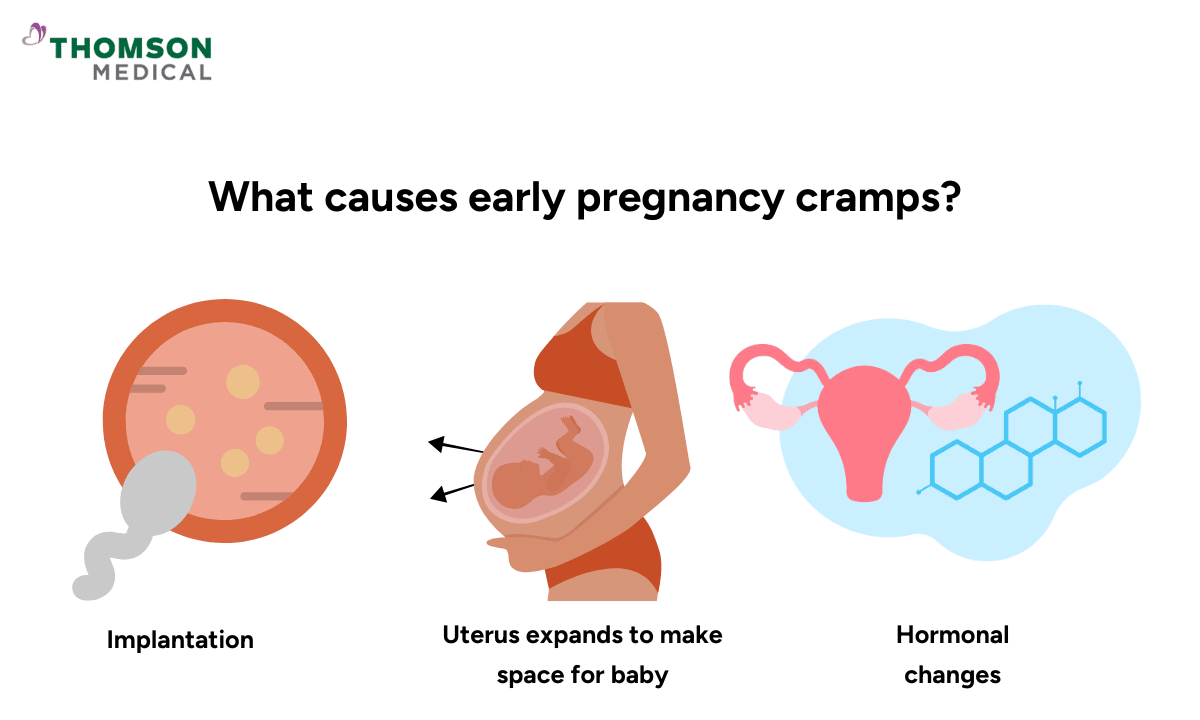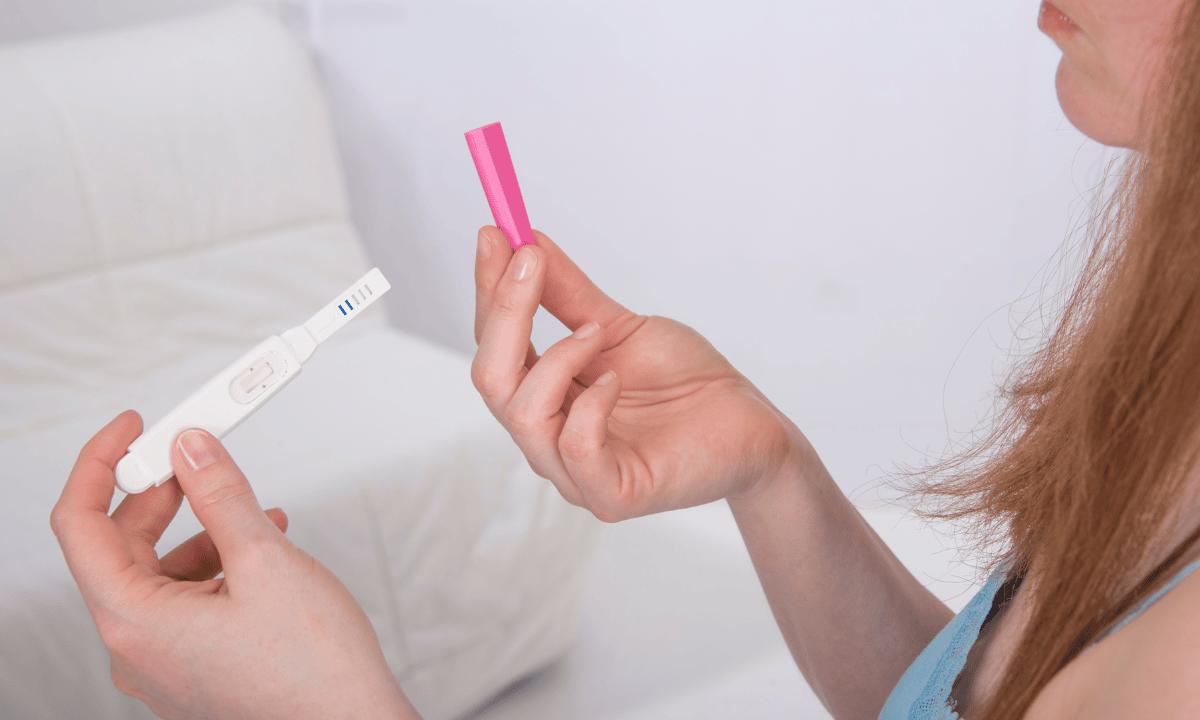Cramps can be quite unpredictable, can't they? One minute you’re convinced your period is coming, and the next you’re wondering if it’s an early sign of pregnancy. It can be a bit overwhelming – especially when you’re waiting, hoping or even worrying about what those twinges mean.
You might find yourself overthinking every little sensation in your belly, scrolling through forums at midnight or comparing notes with friends. If that sounds like you, you’re not alone. Many women go through the same emotions and questions.
Knowing the difference between period cramps and early pregnancy cramps can make this stage a bit less confusing.
What are period cramps?
Menstrual cramps (also called period cramps or dysmenorrhea) are the aching or throbbing pain that many women experience in the lower abdomen or pelvis during their menstrual period.
Why does it happen?
Each month, the uterus contracts to help shed its lining (which is called menstruation).
These contractions are triggered by hormone-like substances called prostaglandins.
Higher levels of prostaglandins can make the uterine contractions stronger and more painful.
What does it feel like?
Dull, throbbing, or cramping pain in the lower belly
Pain may radiate to the lower back or thighs
Sometimes, the pain is accompanied by symptoms such as nausea, fatigue, diarrhoea, or headaches
Types of period cramps
Primary dysmenorrhoea:
Common cramps are not linked to other health conditions and usually start in teenage years.
Secondary dysmenorrhoea:
Conditions such as endometriosis, fibroids, or pelvic infections can cause cramps.
What are early pregnancy cramps, and what causes them?

Early pregnancy pain or cramps are mild abdominal or pelvic pains that many women experience in the first weeks of pregnancy.
It’s normal to feel some cramping during early pregnancy. One common reason is implantation, when the fertilised egg attaches itself to the uterine lining. This can cause light cramps and sometimes a little spotting.
As the pregnancy progresses, your uterus naturally stretches to make space for your growing baby, which may feel like gentle cramping, pulling, or pressure in the lower tummy. Hormonal changes, especially higher levels of progesterone, also relax the muscles and increase blood flow to the pelvis, which may also contribute to the feeling of cramps.
Unlike period cramps, these are usually not severe and should not interfere with daily activities.
Period cramps vs. early pregnancy cramps
| Feature | Period cramps | Early pregnancy cramps |
|---|---|---|
Location | Felt in the lower abdomen; may spread to lower back, hips, or thighs | Felt mainly in the lower abdomen or pelvic area; often described as a mild pulling, stretching, or pressure |
Duration | Usually begin 1-2 days before period and last 2-3 days into menstruation; pain may be constant or come in waves | Shorter and milder; may last minutes to a few hours at a time; usually come and go |
Timing | Occur predictably before and during menstruation; stop once bleeding is over | Can occur around the time of expected period or slightly earlier (implantation); continue intermittently in early weeks of pregnancy |
Intensity | Often stronger, throbbing, or sharp | Usually milder, gentle, or dull |
Associated signs | Menstrual bleeding, bloating, mood changes, or fatigue | Light spotting (implantation), breast tenderness, nausea, and missed period |
Causes | Uterus contracting to shed lining | Uterus stretching, implantation, or hormonal changes (progesterone rise) |
For more personalised information about the period or early pregnancy cramps and to discuss your individual circumstances, consider consulting a fertility specialist. You can contact Thomson Medical to arrange a consultation and receive guidance tailored to your needs.
Our fertility specialists
Loading...
When to take a pregnancy test?

Cramps alone can be confusing since they can feel similar in early pregnancy and before a period. While implantation cramps can begin as early as 6-10 days after ovulation, it’s usually too early to test at that stage. Even though implantation triggers human chorionic gonadotropin (hCG) production, the hormone levels may not be high enough for a test to detect right away.
For this reason, the most reliable time to take a home pregnancy test is after you’ve missed your period. At this stage, hCG levels are usually high enough to be detected in urine. While some early-detection tests can be used a few days before your period is due, testing too soon still carries the risk of false negatives.
For best accuracy, it’s generally recommended to wait about two weeks after ovulation or until the day of your missed period. If your first test is negative but you still suspect pregnancy, repeat the test 3-5 days later.
A blood test at a clinic can detect pregnancy even earlier and with greater accuracy than urine tests.
How to deal with period cramps vs. early pregnancy cramps?
Period cramps
Period pain is common, but there are several effective ways to manage it:
Take over-the-counter pain relief such as ibuprofen or paracetamol to reduce pain and inflammation.
Apply a warm compress or hot water bottle to the lower abdomen to relax uterine muscles.
Try light exercise, stretching, or yoga to improve blood flow.
Shift positions or adjust your posture if sitting or lying down feels uncomfortable.
Stay hydrated and limit caffeine, as caffeine can tighten blood vessels and make cramps worse.
Getting adequate rest can also ease discomfort.
If menstrual pain interferes with daily life and doesn’t improve with these measures, consult a healthcare provider.
Early pregnancy cramps
Cramps in early pregnancy are usually mild and manageable without strong medication. Since many painkillers are not recommended during pregnancy, safer approaches are best:
Use a warm (not hot) compress on the lower belly for gentle relief.
Stay hydrated, as dehydration can make cramps worse.
Try gentle stretching or light walking to ease tension.
Shift your position or rest if cramps appear.
When to see a doctor?
Mild cramping is often a normal part of both menstruation and early pregnancy, but you should know when it might signal something more serious and when to seek medical help. For menstrual cramps, you should see a doctor if the pain is unusually severe or long-lasting, or if it doesn’t improve with over-the-counter pain relief, heat, rest, or lifestyle changes.
If cramps interfere with your day-to-day activities, they could indicate an underlying condition such as endometriosis or fibroids that need evaluation. During pregnancy, you should seek urgent medical care if cramps come with heavy bleeding, sharp or one-sided pain, fever, dizziness or fainting, or foul-smelling vaginal discharge. These symptoms can point to complications such as miscarriage, ectopic pregnancy, or infection, and getting timely care is essential to protect your health and your baby’s.
FAQ
Do early pregnancy cramps feel like period cramps?
Yes, early pregnancy cramps can feel very similar to period cramps, which is why many women confuse the two. Both are usually felt in the lower abdomen as a dull ache, pressure, or mild pulling sensation. The difference is that period cramps are often stronger, last longer, and happen in the days leading up to and during menstrual bleeding.
Early pregnancy cramps are typically milder and shorter and may feel more like gentle twinges or stretching. They can occur around the time your menstrual cycle is due or slightly earlier with implantation, but unlike period cramps, they don’t lead to menstrual bleeding.
Why do I feel like my period is coming but no period?
This can happen in early pregnancy, when hormonal changes feel similar to premenstrual syndrome (PMS) symptoms. A missed period followed by cramps or spotting may mean it’s time to test.
How do I know if it's my period coming or if I'm pregnant?
Both can cause cramps, bloating, breast tenderness, and mood swings, which makes it hard to tell. If your period doesn’t arrive on time, the only reliable way to know is by taking a pregnancy test.
Can I get pregnancy symptoms before a missed period?
Yes, some women notice fatigue, breast tenderness, nausea, or light spotting before a missed period. These symptoms are not proof of pregnancy, so testing is the only way to confirm.
Why do my cramps feel earlier than usual, even when I’m not pregnant?
Cramps can occur for other reasons like ovulation, digestive issues, or pelvic conditions like endometriosis. Early pregnancy is one possibility among many.
Is light spotting normal with early pregnancy cramps?
Yes. Light bleeding, often called implantation bleeding, can happen when a fertilised egg attaches to the lining of your uterine wall. It’s usually much lighter than a period and may appear pink or brown, lasting from a few hours to a couple of days. However, if the bleeding is heavy, ongoing, or paired with severe pain, fever, or chills, you should contact a healthcare provider.
Does cramping during ovulation mean pregnancy?
No, cramping during ovulation is not a sign of pregnancy. It usually happens mid-cycle when the ovary releases an egg, and it’s a normal part of the menstrual cycle. Pregnancy can only occur if the egg is fertilised afterward.
The information provided is intended for general guidance only and should not be considered medical advice. For personalised recommendations based on your medical conditions, request an appointment with Thomson Medical.
For more information, contact us:
Thomson Fertility Centre
- Paragon: 6252 7766
Thomson Specialists (Women's Health)
Thomson Women's Clinic
- Novena:
6592 6686 (Call), 8611 8986 (WA) - Bukit Batok:
6569 0668 (Call), 8686 3525 (WA) - Choa Chu Kang:
6893 1227 (Call), 8282 1796 (WA) Jurong:
6262 8588 (Call), 6262 8588 (WA)- Katong (female doctor):
6970 2272 (Call), 8611 9020 (WA) - Punggol:
6243 6843 (Call), 8811 0328 (WA) - Sembawang: 6753 5228
- Sengkang: 6388 8125
- Serangoon (female doctor): 6382 3313
- Tampines: 6857 6266
- Tiong Bahru: 6276 1525
